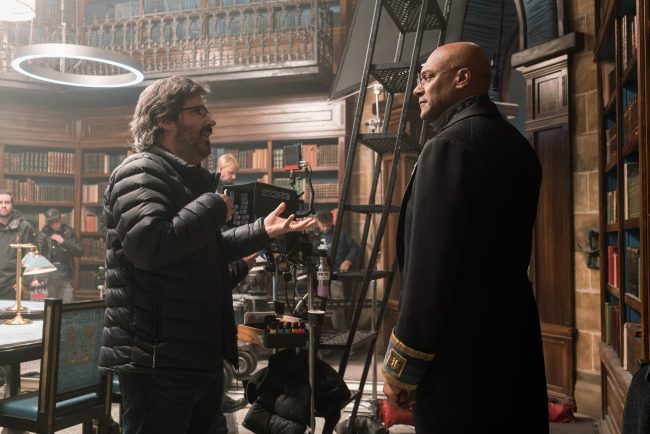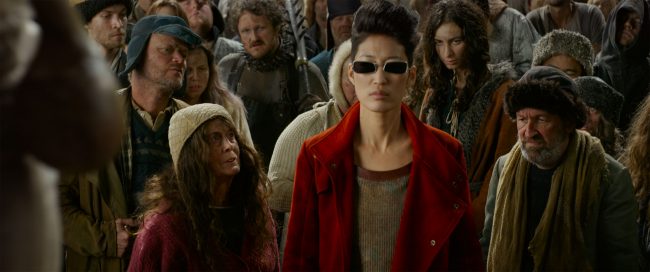Universal is set to release a live action adaptation of Philip Reeve’s best-selling book series The Mortal Engines on December 14, 2018.
“Thousands of years after civilization was destroyed by a cataclysmic event, humankind has adapted and a new way of living has evolved. Gigantic moving cities now roam the Earth, ruthlessly preying upon smaller traction towns. Tom Natsworthy (Robert Sheehan)—who hails from a Lower Tier of the great traction city of London—finds himself fighting for his own survival after he encounters the dangerous fugitive Hester Shaw (Hera Hilmar). Two opposites, whose paths should never have crossed, forge an unlikely alliance that is destined to change the course of the future.”
Last year our own Ashley Victoria Robinson was fortunate enough to visit the set of The Mortal Engines and interview many of the creative forces behind this major motion pictures – including Bob Buck. Buck is a Costume Designer who has worked previously with Peter Jackson on both The Lord of the Rings and The Hobbit trilogy of movies and the Academy-Award winning film The Last Samurai to name a few. He is the Costume Designer for Mortal Engines.
Mortal Engines – Official Trailer (HD)
Thousands of years after civilization was destroyed by a cataclysmic event, humankind has adapted and a new way of living has evolved. Gigantic moving citie…
(Ashley’s note: Unlike the rest of our interviews, Buck was giving a tour of his office and workrooms while he was speaking with press.)
BOB BUCK: [In the trailer you can see] Londoners for the future. We’re trying to make it up as we go along.
Which character’s costume are you most proud of?
BB: Well, we haven’t finished yet, so I don’t know. It could be Crome, we’ve still got them to go. You know, it’s hard to say. We hardly get a chance to stop and actually sort of look back, really. So now, I’m not going to answer it, you know, give a favorite. Pomeroy is quite cool, though.

We saw his [tie]pin. So that’s pretty cool.
(Ashley’s note: it’s the same tie pin that was worn by Bilbo Baggins in The Hobbit movies and has an acorn embossed on it)
BB: Yeah. It’s good to be able to pop some little senses of humor in, when you see them around the set with things like that, trying to inject that in there with the costumes. That’s a great opportunity. You don’t often get the chance.
What kind of cues do you take from the source material? As in the book? Do you take any specific costume direction?
BB: Yeah. Well, I read the books a long, long time ago, so there’s something always in your head about what you imagine it, because they are such visual books. You just really get taken away. So you sort of have that in your head, so I think that comes in as well, what you get in terms of the rewrite of the script and also the feedback from Peter [Jackson], Fran [Walsh] and Phil[ippa Boyens]6.
But yeah, it’s intuitive, really. And also trying to think about the next book. I have read them, so you do know, “Okay, well he’s from this sort of world and that’s sort of going to happen,” so you need to try and evoke that and open up things for future readers.
There are I’ve scenes with quite a few extras. What’s the biggest or the largest amount of people that you had to service in one day?
BB: I don’t count. I just “Next, next, next.” I think it’s been up to 180 or so. Something like that. You know, with people coming in, like [Saltzhagen] and then the people processing them, the gut workers and all that sort of thing. Yeah, it’s not as huge as what we’ve done in the past, but yes, it’s [a lot of]people, especially when you’re making everything from scratch.
It’s that sort of world of, you know–what we are doing with the London is we are going out there and doing a lot of secondhand shopping to try and get to that eclectic mix of things. You know, if you look at it as a group of people, you’re wearing all sorts of things. And if we went into a mall or whatever, we’d try to make it. It would all just be too contrived and too over-designed, I suppose, in some ways.
But we try and get that random quality of getting all of that stuff from secondhand outlet source stores, and then you start putting it together because London is about scavenging and repurpose thing and things like that. So we’re getting outfits, putting them together. A little bit poppy, sort of there’s a punk attitude where they’re sort of breaking the rules sort of thing with that sort of feeling of London, but then we are sort of deconstructing them as well and painting on them or chopping bits off and putting another fabric on, because they are shorter–there’s theories where only the rich have clothes that are fully of one fabric.
That’s why in lots of ways I like Valentine and Katherine are a lot simpler and a lot sort of more monochromatic. But then with the people in the gut, they’re completely like–they’ve got puffer jackets stuck on the back of another jacket and they’ve just got this and they’ve got that and they have to sort of make what they can.

Dealing with tier one through tier seven, what is the kind of progression there as you go from kind of the upper class to the lower class?
BB: Well, we’ve really done the gut and that was just, you know, as you would imagine, do as you must and you try and control the colors with your greens and your khakis and your browns, popping a little bit of color in like bright yellows that look almost like sort of the utility colors of London, because these are the colors which are around the city.
And as you go up, you start introducing more colors. We keep them sort of more muted, but then they start popping in more aesthetic as we go to the top and then when we go to the top tier, we’re really pushing into sort of like the swinging ’60s … sort of full-on, like, oranges and pinks together and bright sort of acid sort of colors.
And of course, you can’t do that with your lead character, so you do it in the extras, and that’s, you know, giving it a fun atmosphere. And you’ve got to remember that we also have London happening at the same time as Shan Guo is happening towards the end, so you want to make sure there is a distinction. The difficulty is, I suppose, of still trying to get a lot of color going on.
In terms of making a difference, we’re really trying to get London a much more formal sort of structured and sort of controlled while Shan Gup is a lot more looser and relaxed and a little bit more ethnic and a lot more possibly tribal, I suppose. Yeah.
Mortal Engines opens in theatres worldwide December 14, 2018.



